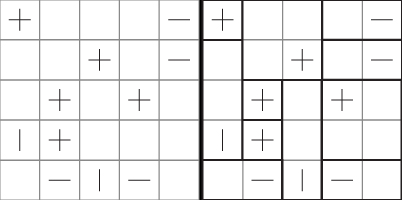Feel free to share
 Using this site means trees will be planted. ^.^
Using this site means trees will be planted. ^.^
(Find out more)
Tatamibari
Tatamibari is a Nikoli puzzle in which the aim of the game is to divide a grid into squares and rectangles based on the icons within it. It can be played on any sized grid, but the bigger the grid the bigger the challenge usually becomes. This does depend more on the rooms and hints, rather than the size of the grid however.
The rules are as follows:
- Divide the grid into rooms based on the icons within the grid.
- + icons must be inside a square room.
- - icons must be in a rectangular room of which the width is greater than its height.
- | icons must be in a rectangular room of which the height is greater than its width.
- All rooms must have 1 icon in them.
Standard version
Tatamibari's usually not a difficult game. The challenge often only lies in figuring out whether a room's supposed to be one cell bigger or smaller, but this is usually resolve pretty swiftly once other rooms have a definitive answer. These answers are often found easily thanks to some easy deduction work, as clusters of icons often leave little to no room for anything other than a single answer.
Many puzzles (including my own example) have multiple answers however, but this is something that will only matter when you adapt your puzzle in specific ways.

Converting it to an RPG setting.
Depending on the size of the field you're playing with, Tatamibari can be tricky to adapt to an RPG setting. There are some ways though. The layout of a town, stacks of various crates (one of which might be important), plots of farm land, animal shelters, and so on.
I've gone with the layout of a building for my example. My character's trying to infiltrate a building, but all she's been given is a note with the symbols, and the instructions on how to solve a Tatamibari puzzle. She's also told solving this will reveal the layout of the building, but she won't know what's inside each room until she actually enters them. I added the doors below purely for effect, my character won't know they're there untils she actually sees and/or finds them.

If she figures out the puzzle and thus the layout of the building she'll know of secret rooms accessible only through secret doors. These'll lead to loot or perhaps plot relevant secrets, but without the map and thus the knowledge of these rooms she'll likely miss these rooms when making her way through the building.
As mentioned my puzzle has multiple solutions. The top left '+' could fit into a 2x2 room, then the top right '-' could extend one further to the left. The top middle '+' would then fit in a 1x1 cell. This matters only if you put relevant information/items/etc. in these rooms, and only in such a way that the alternative version would break this. So plan ahead if this'll matter to your game.
Alternatively, stick to puzzles with a unique solution or add the relevant items after your group has figured out one of the solutions. Having said that, using a puzzle with multiple solutions can speed things up a bit, which is useful for some groups.